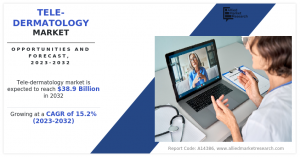Teledermatology Market - Revolutionizing Skin Care in the Digital Age
PORTLAND, OR, UNITED STATES, March 5, 2025 /EINPresswire.com/ -- The global healthcare industry is witnessing a significant transformation, with telemedicine emerging as a key driver of modern patient care. Among its various applications, teledermatology has gained substantial traction, offering an accessible, cost-effective, and efficient approach to diagnosing and managing skin conditions. According to a report by Allied Market Research, the teledermatology market, valued at $9.5 billion in 2022, is projected to surge to $38.9 billion by 2032, growing at a CAGR of 15.2%. This rapid expansion is fueled by increasing skin disorder prevalence, technological advancements, and the adoption of patient-centered care models.Get a Sample Copy of this Report: https://www.alliedmarketresearch.com/request-sample/A14386
Understanding Teledermatology
Teledermatology is a specialized field of dermatology that utilizes telemedicine technologies to provide remote skin care. It operates through two primary modalities:
• Store-and-Forward (Asynchronous): Patients send images and medical histories to dermatologists, who review them and provide diagnoses or treatment plans later.
• Real-Time (Synchronous): Live video consultations enable direct interaction between patients and dermatologists for immediate assessment and recommendations.
This approach extends dermatologists’ reach to underserved areas, improving access to quality dermatological care.
Market Growth Drivers
1. Increasing Prevalence of Skin Disorders
• Skin conditions like eczema, psoriasis, and skin cancer are on the rise worldwide.
• 223 million people globally suffered from atopic dermatitis in 2022, with 43 million children affected.
• Teledermatology facilitates early diagnosis and timely management, reducing disease burden.
2. Advancements in Technology
• Artificial intelligence (AI) and machine learning (ML) enhance diagnostic accuracy.
• AI-based apps, like DermaAid, diagnose over 50 skin conditions with 80% accuracy.
• High-resolution imaging and video conferencing improve remote consultations.
3. Shift Toward Patient-Centered Care
• Reduces the need for in-person visits, saving time and costs.
• Enables flexible consultations, including home-based dermatological care.
4. Government Support and Policy Initiatives
• Many governments are expanding reimbursement options for teledermatology services.
• Regulatory barriers are being eased to encourage wider adoption.
Market Segmentation and Emerging Trends
By Type
• Services: Dominated the market in 2022 due to increasing teleconsultation awareness.
• Products: Expected to grow significantly, driven by rising demand for dermatoscopes and digital imaging tools.
By Modality
• Store-and-Forward: Leading segment due to its efficiency in diagnosing skin conditions.
• Real-Time: Anticipated to grow at the highest CAGR, aided by improved digital imaging and video conferencing.
By End User
• Homecare: The largest segment in 2022, driven by affordability and convenience.
• Healthcare Units: Expected to grow as some cases require in-person procedures like biopsies.
By Region
• North America: Held the largest market share in 2022, with key players like DermatologistOnCall and MDLive.
• Asia-Pacific: Forecasted to grow at the fastest rate due to increasing healthcare expenditure and rising skin disorder cases.
Challenges and Opportunities
Key Challenges
• Dependence on high-quality imaging and stable internet connectivity.
• Regulatory and reimbursement barriers in some regions.
Opportunities
• Innovations in AI and ML for automated diagnosis.
• Enhanced collaboration among healthcare providers, tech companies, and policymakers to improve accessibility and affordability.
Competitive Landscape
Major players in the teledermatology market include:
• Teladoc Health, Inc.
• 3Derm Systems Inc.
• Ksyos Telemedical Centre
• Medweb
• Advanced TeleMed Services
These companies are heavily investing in R&D to enhance product offerings and expand market presence.
The Future of Teledermatology
With ongoing technological advancements and a growing emphasis on patient-centered care, teledermatology is set to become an integral part of global dermatology practices. Its potential to bridge healthcare gaps, lower costs, and improve patient outcomes underscores its transformative impact on dermatological care.
Key Takeaways
• Teledermatology offers remote, efficient, and cost-effective skin care solutions.
• Market growth is driven by rising skin disease prevalence, AI integration, and supportive policies.
• North America leads, while Asia-Pacific is expected to witness the highest growth.
• AI and ML are enhancing diagnostic accuracy and patient engagement.
• Despite challenges, innovations and policy support will propel teledermatology forward.
Conclusion
Teledermatology represents a paradigm shift in dermatological care, making high-quality treatment accessible to all, regardless of geographic or economic constraints. As the market continues to expand, it will play a pivotal role in shaping the future of digital healthcare.
Enquire Before Buying: https://www.alliedmarketresearch.com/purchase-enquiry/A14386
David Correa
Allied Market Research
+ 1 800-792-5285
email us here
Visit us on social media:
Facebook
X
LinkedIn
YouTube
Legal Disclaimer:
EIN Presswire provides this news content "as is" without warranty of any kind. We do not accept any responsibility or liability for the accuracy, content, images, videos, licenses, completeness, legality, or reliability of the information contained in this article. If you have any complaints or copyright issues related to this article, kindly contact the author above.

